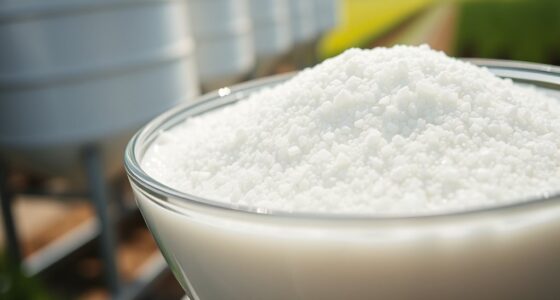Anti-freezing proteins inspired by fish and plants help ice cream stay smooth and creamy by preventing large ice crystals from forming during freezing. These proteins bind to crystal surfaces and create a protective network, keeping ice crystals small even over time. By mimicking nature’s strategies, food scientists can improve texture, extend shelf life, and deliver consistent quality. If you continue exploring, you’ll discover how these natural adaptations are revolutionizing ice cream science.
Key Takeaways
- Anti-freezing proteins prevent large ice crystal growth in ice cream, inspired by fish and plants that survive freezing conditions.
- They bind to ice crystal surfaces, inhibiting growth and maintaining a smooth, creamy texture during storage.
- Natural antifreeze mechanisms from cold-adapted organisms inform the development of food-grade stabilizers.
- Incorporating these proteins enhances ice cream shelf life, texture, and sensory qualities by controlling ice crystal formation.
- Advances in protein engineering optimize antifreeze proteins for commercial ice cream applications, mimicking nature’s protective strategies.

Ever wondered how ice cream stays smooth and scoopable even at temperatures below freezing? It’s a fascinating blend of science and culinary art, where anti-freezing proteins play a vital role. These specialized proteins, borrowed from nature’s most resilient creatures like fish and certain plants, help prevent the formation of large ice crystals. When ice cream freezes, the goal is to keep its texture creamy and inviting, not icy and gritty. That’s where protein stabilization comes into play. These proteins interfere with ice crystal growth, binding to the crystal surfaces and halting their expansion. By doing so, they maintain a finer, more uniform ice structure. This process not only prevents the ice from becoming too coarse but also enhances the overall texture, giving you that smooth, velvety mouthfeel you expect from premium ice cream.
The concept of texture enhancement is central to creating a product that’s both enjoyable and consistent. Without these anti-freezing proteins, the freezing process would lead to large, sharp ice crystals that damage the delicate matrix of fats, sugars, and proteins that give ice cream its characteristic creaminess. Instead, the proteins act as tiny guardians, stabilizing the structure at a microscopic level. They form a protective network around the water molecules, effectively lowering the temperature at which ice crystals form and grow. This means that even when stored at temperatures that typically induce ice crystal formation, the proteins keep the ice crystals small and less disruptive. As a result, your ice cream remains smooth and scoopable, with a less icy texture and more of that rich, indulgent mouthfeel.
These anti-freezing proteins are inspired by natural adaptations. Fish living in icy waters produce antifreeze proteins that prevent their blood from freezing solid, enabling survival in extreme cold. Similarly, certain plants produce proteins that help them withstand freezing conditions. By harnessing these biological strategies, scientists have developed ways to incorporate similar proteins into ice cream formulations. This innovation not only improves the sensory qualities of the dessert but also extends shelf life by reducing ice crystal growth over time. Additionally, advances in protein engineering have allowed for more efficient and targeted use of these proteins in food applications. So, when you enjoy a scoop of ice cream that stays perfectly smooth even after hours in the freezer, you’re witnessing the marvel of protein stabilization and texture enhancement—an elegant solution derived from nature’s own cold-resistant adaptations.
Frequently Asked Questions
How Do Anti-Freezing Proteins Affect Ice Cream Texture?
Anti-freezing proteins improve ice cream texture by preventing large ice crystal formation, leading to smoother texture and enhanced mouthfeel. They help control melting behavior, making the ice cream stay creamy longer and melt evenly. By incorporating these proteins, you can enjoy a more consistent, enjoyable experience, as they promote texture enhancement and stability. This results in ice cream that’s irresistibly smooth and melts just right.
Are Anti-Freezing Proteins Safe for Human Consumption?
You’ll be glad to know that anti-freezing proteins are generally safe for human consumption, with extensive research supporting their safety. Only around 2% of new food ingredients face regulatory approval, so these proteins undergo rigorous testing for food allergenicity. Regulatory agencies carefully evaluate their safety before approval, ensuring they won’t pose health risks. As long as they’re approved, you can enjoy ice cream containing these proteins without concern.
Can Anti-Freezing Proteins Be Used in Homemade Ice Cream?
Yes, you can use anti-freezing proteins in homemade ice cream, but it requires careful home recipe modifications. You might explore natural ingredient alternatives like honey or alcohol, which lower freezing points. Incorporate small amounts gradually, testing texture and consistency. Keep in mind that sourcing anti-freezing proteins safely for home use can be challenging, so focus on natural ingredients that help prevent ice crystal formation while ensuring your ice cream remains delicious and safe.
What Are the Environmental Impacts of Using Anti-Freezing Proteins?
Using anti-freezing proteins can raise environmental concerns, mainly biodegradability issues and ecosystem disruption. You might worry that these proteins don’t break down easily, potentially accumulating in the environment. Additionally, if released in large amounts, they could affect local ecosystems by altering natural freezing processes or harming native species. It’s essential to carefully evaluate their environmental impact, ensuring they’re safe and sustainable before widespread use.
How Cost-Effective Are Anti-Freezing Proteins for Commercial Ice Cream Production?
Imagine slicing through costs like a hot knife through butter—that’s what anti-freezing proteins can do for your ice cream production. They’re relatively cost-effective when you consider the benefits, but a thorough cost analysis is essential. You’ll need to evaluate production scalability, as larger operations may benefit more. While initial expenses might be higher, long-term savings and quality improvements make anti-freezing proteins a smart investment for competitive advantage.
Conclusion
So, next time you’re savoring that perfectly scoopable ice cream, thank those tiny anti-freezing proteins from fish and plants—because without them, your dessert might just be a frozen disaster. Who knew that nature’s icy heroes are secretly working behind the scenes, saving your sweet treat from becoming a block of ice? So go ahead, indulge confidently—your ice cream has some serious cold-weather heroes keeping it soft and delicious. Cheers to science’s coolest miracles!










